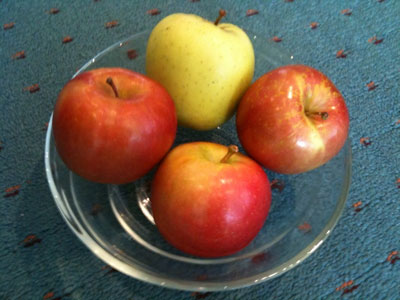Fructose Malabsorption

Sugar, Sugar
Does an apple a day really keep the doctor away? For some maybe, but for a growing number of people (myself included) this may no longer be the case. What do I mean by this exactly? Well, I'm talking about a little-known condition called Fructose Malabsorption.
I had never heard of this intolerance up until a few years ago when I was diagnosed. Before then, I was happy with my diet filled with a lot of fruit (and I mean a lot) and wheat based foods. Apples and pears were among my ultimate favourite fruits to eat, along with grapes, sultanas, dates and nectarines. I got to the point where I was absolutely, desperately craving apples and I could eat up to three a day amongst all the other fruit, I was eating as well. Along with the extensive amount of fruit in my diet, I was also eating a lot of wheat. I was always making high-fibre fruit muffins and fruit cakes; pasta and Turkish bread were my weaknesses. Basically anything containing fruit and wheat I would eat!
Why so much fruit? Well, I had made the decision to get healthy and lose a bit of weight, so turning to lots of fruit would be the optimal choice right? Wrong! All this fruit and wheat based food was the root of my stomach and digestive problems.
As someone who has had issues with her stomach for most of her life, I didn't really take much notice of the symptoms I was having. I was however, becoming much more tired than usual, my moods were up and down, I had stomach aches and cramps, and to put it nicely, I was spending more time in the bathroom than I would've liked. After a month or so, I went to the doctor and was put on a wheat elimination diet. My energy levels improved, but the stomach symptoms still persisted.
The next step was to be referred to a Gastroenterologist and eventually I was breath-tested for lactose intolerance and Fructose Malabsorption. The lactose test came back negative, which I was extremely thankful for (what would I do without milk and ice-cream?), but the fructose test was positive. So what did this now mean? This meant I had to cut right back on and eliminate certain types of fruit, vegetables, wheat/rye/spelt products, honey, and anything with excess sucrose (white sugar). It meant learning to read food labels, checking to see what contained fructose, where it was placed in the ingredients list (the higher up, the more the fructose it contained) and finding out my fructose threshold.
So what is Fructose Malabsorption exactly? Previously known as 'dietary fructose intolerance', Fructose Malabsorption is a digestive disorder of the small intestine, in which the fructose carrier in the intestinal cells is deficient. This causes the concentration of fructose in the entire intestine to be increased, resulting in stomach and digestive symptoms. It should be noted that Fructose Malabsorption is not the same as Hereditary Fructose Intolerance (HFI), a condition in which the enzymes in the liver, which break up fructose do not function properly.
I thought that I had done this to myself by eating too much of the same food over and over again. I remember being told that you can become intolerant to certain foods if you constantly eat too much of them. Whether or not that's true, apparently this wasn't the case. It is not known exactly what causes Fructose Malabsorption, a couple of possibilities could be to do with a person's genetic make up, diet, or even some sort of underlying stomach/digestive disorder.
So what should you be looking to include and eliminate as part of a fructose restricted diet?
Not so 'safe' foods:
Apples, pears, mangoes, honey, onions, fruit pastes/chutneys, dried fruits, fruit juice, and wheat products (as a main ingredient).
Some 'safe' foods:
All berries, oranges, bananas, kiwifruit, passion fruit, potatoes, pumpkin, sweet potato, eggplant, rice and gluten free products (pasta, rice, bread, rice noodles, biscuits).
The reason gluten free products are considered a safe choice for Fructose Malabsorption is not because they contain no gluten, but because they are free of wheat, which contains a chain of fructose molecules. It's the sugar in the wheat that causes the problems, not gluten. So unless you have a gluten allergy or celiac disease, products that contain gluten or wheat as an ingredient should be safe.
If you find yourself diagnosed with Fructose Malabsorption it will take time and patience to find out where your tolerance threshold lies. Depending on your symptoms and the severity of your condition, you may find that you're okay with a small amount of certain 'unsafe' foods. I often find myself 'cheating' and I'll treat myself to whole-wheat bread, I also still eat a lot of fruit, probably more than I should, but only from the safe list, I just know now where my limits are.
The hardest part is eating out at restaurants. When you tell wait staff you have fructose intolerance they can often have a look on their face as if you just spoke to them in a complete other language. Through my experience, I've found it best to just ask for gluten-free food and find out if what you want contains any onion or honey. Most places are happy to cater to your needs and will often make up dishes minus the nasty ingredients.
If you think you may be suffering from Fructose Malabsorption or any other sort of food intolerance, make an appointment with your doctor who can arrange for you to be tested.
By Karli Smith
MORE
- Best Snacks For Brain Health
- Antoinette-Louise Barnardo Swisse Kids Health...
- How to Eat Healthy
- 5 Natural Energy-Boosting Habits
- Dr. Ross Walker How Food Can Help With Heart...
- Top 5 Nutrient Boost Tips
- 10 Brain Foods Everyone Should be Eating
- Lee Holmes 2017 Health Trends Interview
- PureBred Seven Day Gluten-Free Challenge
- Study Suggests Poor Quality Diet Linked To...
- I Quit Sugar for Life
- Mad For Health 8 Food Myths
- Never Be Tempted Out Of Your Gluten-Free Diet...
- Melanie McGrice AIA Healthier Habits in 2014...
- Natural Remedies The Latest Buzz For Bites You
- Bosisto's Lavender Packs
- Chillax Natural Sleep Drink
- Beaming with Health Nighty Night
- Blackmores Eco-Krill
- Pamela Hore Bring It To The Table Interview
- Professor Kerin O'Dea Intervention on...



